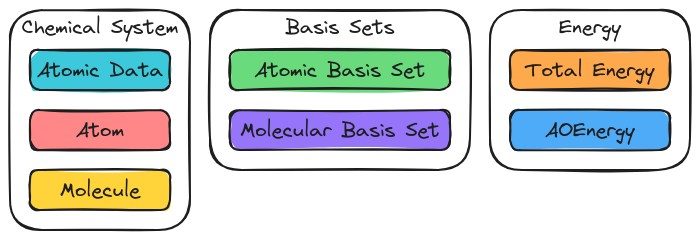SimDE Overview
SimDE Statement of Need listed the reasons that SimDE was necessary. The present section provides a high-level overview of SimDE.
NWChemEx Ecosystem Development Kit
We presume that most users of SimDE are using SimDE as an SDK for creating plugins and/or modules which are compatible with the NWChemEx ecosystem.

Fig. 1 Overview of the SimDE SDK.
Fig. 1 summarizes the structure of the SDK provided by SimDE.
At the base of the SDK are three, somewhat independent, libraries:
ParallelZone is a parallel runtime system. ParallelZone provides abstractions for interacting with the resources (e.g., GPUs, CPUs, memory, processes, and file system) available to the program.
PluginPlay is an inversion-of- control framework which facilitates creating software packages from modular components. The resulting software package can be easily extended by users and developers by adding new modules.
Chemist provides data structures for concepts commonly encountered in computational chemistry (e.g. atoms, molecules, and wavefunctions).
Users of SimDE have direct access to all three of these libraries and are encouraged to use these libraries directly. Generally speaking SimDE users should NOT have to work with the dependencies underpinning ParallelZone, PluginPlay, or Chemist.
Note
If you encounter performance issues with any part of SimDE which would require bypassing the abstractions provided by that component please open an issue with the developers.
NWChemEx Property Types
In addition to serving as a meta-package, SimDE also provides the computational chemistry property types used throughout NWChemEx. Property types help ensure that modular software that is meant to be interoperable adheres to the same interfaces.

Fig. 2 Grouping of property types in SimDE. Within each component are high-level examples of the types of properties property types in that component can compute.
Fig. 2 shows the categories of property types presently in SimDE and the types of properties which can be computed. These categories are summarized below.
Chemical System
Property types in this category are designed to facilitate the creation of objects from the Chemical System component of Chemist. Examples of property types in this category include:
Creation of
Atominstances given the atomic number or atomic symbol.Mapping of string representations of a molecule to
Moleculeinstances.
Basis Set
Property types in this category help create molecular basis sets. Examples of property types include:
Creation of
AtomicBasisSetobjects from atomic number.Creation of
AOBasisSetobjects fromMoleculeobjects.
Energy
Property types in this category compute energies of chemical systems. Examples of property types include:
Computing the total energy of a
ChemicalSystem.Computing the total energy given a
ChemicalSystemand anAOBasisSet.